Genska banka koruze v Sloveniji
The maize gene bank at the Agronomy Department of the Biotechnical Faculty in Ljubljana is one of the oldest and the most comprehensive plant gene banks, COLLECTIONS in Slovenia. The first maize populations were collected in early 1950s. Presently, in our gene bank, there are 587 maize genotypes. Most of the materials represent domestic flint landraces of maize and selected inbreds with different




